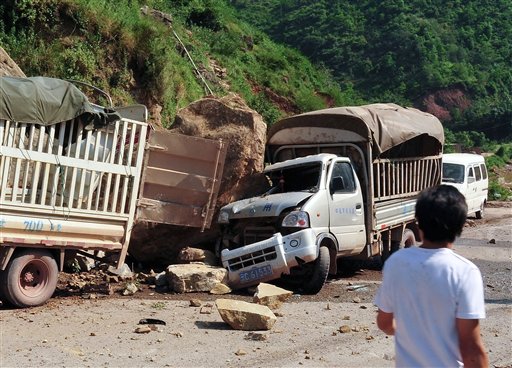By SCOTT McDONALD
Associated Press
BEIJING
Authorities poured aid into a remote mountainous area of southwestern China and rescue workers with sniffer dogs searched for survivors Saturday after twin earthquakes killed at least 80 people.
More than 100,000 residents were evacuated after Friday’s quakes toppled thousands of homes and sent boulders cascading across roads in a region of small farms and mines where some of China’s poorest people live.
The damage was preventing rescuers from reaching outlying towns, and communications were disrupted after the midday quakes hit along the borders of Guizhou and Yunnan provinces. But state television said Saturday that a road into the worst-hit area that had been blocked with fallen boulders was cleared, allowing workers and assistance in.
Still, weather forecasts said there was a chance of rain over the next three days, which could hamper rescue work. The official Xinhua News Agency quoted weather officials as warning of the risk of “rain-triggered geological disasters” such as landslides in the quake-hit region.
There was, however, some uplifting news: State television reported that four babies had been born in temporary hospitals set up since the quakes hit.
The first magnitude-5.6 quake struck just before 11:30 a.m. Friday and was followed by an equally strong quake shortly after noon, joined by dozens of aftershocks. Though of moderate strength, the quakes were shallow, which often causes more damage than deeper ones.
Zhang Junwei, a spokesman for the Yunnan Seismological Bureau, said Saturday that the death toll stood at 80. Yunnan’s civil affairs department said on its website that another 820 people had been injured in the earthquakes.
Hardest hit was Yiliang County, where all but one of the deaths occurred, according to the Yunnan provincial government’s official website. Yiliang’s high population density _ twice the provincial average _ flimsy building construction and landslide-prone hillsides were blamed for the relatively high death toll.
China Central Television showed roads littered with rocks and boulders and pillars of dust rising over hilltops from the landslides.
Other footage showed villages of blue tents being set up for the evacuated, as well as search dogs going through the rubble from destroyed homes. The footage also showed several vehicles that were crushed by large boulders that had swept down mountainsides.
Chinese Premier Wen Jiabao visited the quake area on Saturday and was seen on television consoling survivors and walking through hospitals.
Though quakes occur in the area frequently, buildings in rural areas and China’s fast-growing smaller cities and towns are often constructed poorly. A magnitude-7.9 quake that hit Sichuan province, just north of Yunnan, killed nearly 90,000 people in 2008, with many of the deaths blamed on poorly built structures, including schools.
Yunnan’s civil affairs department said Friday’s quakes destroyed 6,650 houses and damaged 430,000 others. Besides the 100,000 residents already evacuated, another 100,000 were in need of relocation, it said, adding that direct economic losses so far were estimated at 3.5 billion yuan ($551 million).
That included a village near a zinc mine in Luozehe. “It is scary. My brother was killed by falling rocks,” miner Peng Zhuwen told Xinhua. “The aftershocks struck again and again. We are so scared.”
Yunnan Governor Li Jiheng said that as long as there was “a ray of hope” of finding anyone alive, all efforts would be made.
The civil affairs department said more than 10,000 tents, plus a similar number of heavy blankets and winter jackets, had been sent into the area. Other agencies, including the Red Cross, were also sending in supplies, and the government said thousands of soldiers were helping the rescue effort in the area, which is largely inhabited by members of the Yi ethnic minority.
Mobile phone services were down and regular phone lines disrupted. Phones were cut off to clinics in four villages in Qiaoshan, another town in Yiliang, which has about half a million people.
Xinhua said that so far no deaths had been reported in neighboring Guizhou, but that homes had been damaged or destroyed there.
Friday’s quakes were relatively shallow, about 10 kilometers (six miles) deep, creating an intense shaking even at a moderate magnitude.
By comparison, the magnitude-7.6 quake in Costa Rica this week was 40 kilometers (25 miles) below the surface, a fact that, combined with strict building codes, kept damage and deaths to a minimum.

COMMENTS
Please let us know if you're having issues with commenting.